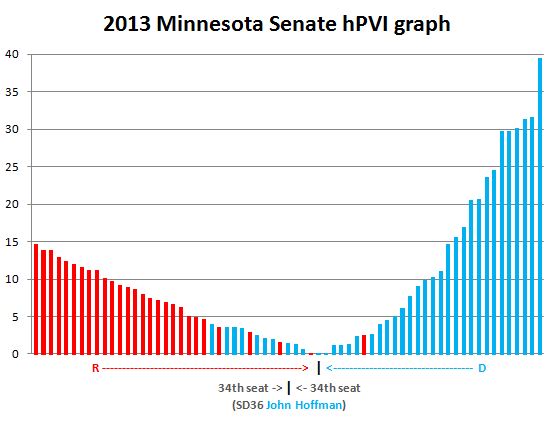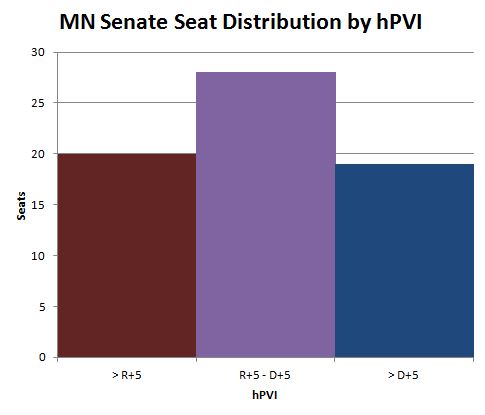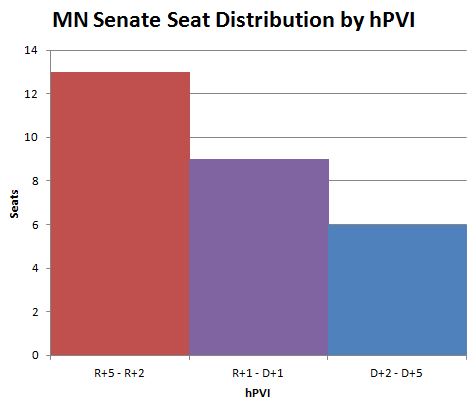
Minnesota Senate hPVI, 2013 edition
This post continues a series of posts concerning hPVI. The first phase of said series of posts involves the introduction of brand spanking new 2013 hPVIs. The first phase is the phase in which we currently find ourselves. All of this implies that this series will go through multiple phases.
This part of the first phase, the second part of the first phase, concerns the actual hPVIs for the Minnesota Senate. The first part of the first phase dealt with some updates to the hPVI formula itself. If you have no idea what hPVI is, you should probably start here.
In the graph below each bar represents a Senate district, the height of the bar representing the hPVI of the district, districts on the left side of the graph are Republican leaning and districts on the right side are Democratic leaning. The color of the bar represents the party that currently occupies the seat.

The first vertical bar acts as the demarcation between Republican and Democratic leaning seats. The location of the 34th seat, the number of seats needed for control of the Senate, is marked by the second vertical bar.
This graph vividly illustrates just how concentrated with Democrats the most Democratic districts are compared to the concentration of Republicans in the most Republican districts.
On the GOP side there is a smooth and gradual incline, giving the Republicans a bunch of strong, if not overwhelmingly so, districts. The DFL side, however, cannot be described as gradual in the least.
The most Republican district in the entire state is 1 point more Republican than the second most Republican district. The most Democratic district is 7 points more Democratic than the second most Democratic district. Even more telling, there are 12 districts that are more concentrated with DFLers than the most Republican district.
The above graph also illustrates the amount of penetration each party has into the others districts; with DFL Senator Vicki Jensen sitting in an R+4 district and GOP Senator Jeremy Miller sitting in a D+3 district.
The graph below breaks down the districts into three buckets, roughly; GOP friendly, competitive and DFL friendly.

Looking at the districts this way there doesn’t seem to be too many differences between the distribution of seats between the two parties. Both have about 20 districts that are moderately favorable or better, and there’s more then 25 districts up for grabs in the middle.
But those seats in the middle are not evenly distributed, as seen in the graph below that further breaks down the R+5 to D+5 range seen in the graph above.

There are more then twice as many districts that fall into the R+5 to R+2 bucket as there are districts that fall into the D+5 to D+2 bucket. So while both parties have roughly the same number of districts that they are strongly favored to win, the Republicans have twice as many districts that give them a more modest advantage.
The DFL is in the majority because they hold a majority of those R+5-R+2 districts and all but two of the R+1-D+5 districts.
Here is the entire Senate hPVI list:
| SD | Senator | Party | hPVI |
| 1 | LeRoy Stumpf | DFL | R+2 |
| 2 | Rod Skoe | DFL | R+4 |
| 3 | Thomas Bakk | DFL | D+11 |
| 4 | Kent Eken | DFL | D+1 |
| 5 | Tom Saxhaug | DFL | D+2 |
| 6 | David Tomassoni | DFL | D+17 |
| 7 | Roger Reinert | DFL | D+21 |
| 8 | Bill Ingebrigtsen | GOP | R+10 |
| 9 | Paul Gazelka | GOP | R+11 |
| 10 | Carrie Ruud | GOP | R+5 |
| 11 | Tony Lourey | DFL | D+6 |
| 12 | Torrey Westrom | GOP | R+7 |
| 13 | Michelle Fischbach | GOP | R+9 |
| 14 | John Pederson | GOP | EVEN |
| 15 | Dave Brown | GOP | R+12 |
| 16 | Gary Dahms | GOP | R+7 |
| 17 | Lyle Koenen | DFL | R+2 |
| 18 | Scott Newman | GOP | R+12 |
| 19 | Kathy Sheran | DFL | D+5 |
| 20 | Kevin Dahle | DFL | R+4 |
| 21 | Matt Schmit | DFL | R+4 |
| 22 | Bill Weber | GOP | R+7 |
| 23 | Julie Rosen | GOP | R+7 |
| 24 | Vicki Jensen | DFL | R+4 |
| 25 | David Senjem | GOP | R+3 |
| 26 | Carla Nelson | GOP | R+2 |
| 27 | Dan Sparks | DFL | D+8 |
| 28 | Jeremy Miller | GOP | D+3 |
| 29 | Bruce Anderson | GOP | R+12 |
| 30 | Mary Kiffmeyer | GOP | R+14 |
| 31 | Michelle Benson | GOP | R+13 |
| 32 | Sean Nienow | GOP | R+8 |
| 33 | David Osmek | GOP | R+13 |
| 34 | Warren Limmer | GOP | R+9 |
| 35 | Branden Petersen | GOP | R+9 |
| 36 | John Hoffman | DFL | R+1 |
| 37 | Alice Johnson | DFL | EVEN |
| 38 | Roger Chamberlain | GOP | R+6 |
| 39 | Karin Housley | GOP | R+5 |
| 40 | Chris Eaton | DFL | D+15 |
| 41 | Barbara Goodwin | DFL | D+10 |
| 42 | Bev Scalze | DFL | D+3 |
| 43 | Charles Wiger | DFL | D+5 |
| 44 | Terri Bonoff | DFL | R+1 |
| 45 | Ann Rest | DFL | D+10 |
| 46 | Ron Latz | DFL | D+14 |
| 47 | Julianne Ortman | GOP | R+15 |
| 48 | David Hann | GOP | R+4 |
| 49 | Melisa Franzen | DFL | EVEN |
| 50 | Melissa Wiklund | DFL | D+9 |
| 51 | Jim Carlson | DFL | D+2 |
| 52 | James Metzen | DFL | D+4 |
| 53 | Susan Kent | DFL | R+1 |
| 54 | Katie Sieben | DFL | D+1 |
| 55 | Eric Pratt | GOP | R+11 |
| 56 | Dan Hall | GOP | R+4 |
| 57 | Greg Clausen | DFL | R+2 |
| 58 | Dave Thompson | GOP | R+10 |
| 59 | Bobby Joe Champion | DFL | D+33 |
| 60 | Kari Dziedzic | DFL | D+31 |
| 61 | Scott Dibble | DFL | D+30 |
| 62 | Jeff Hayden | DFL | D+38 |
| 63 | Patricia Torres Ray | DFL | D+29 |
| 64 | Dick Cohen | DFL | D+25 |
| 65 | Sandy Pappas | DFL | D+32 |
| 66 | John Marty | DFL | D+20 |
| 67 | Foung Hawj | DFL | D+24 |
Thanks for your feedback. If we like what you have to say, it may appear in a future post of reader reactions.


